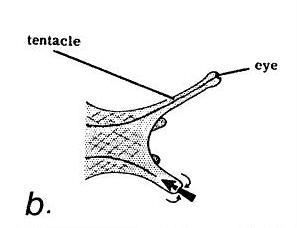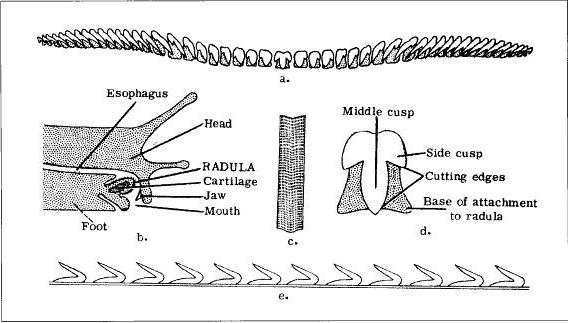
Adaptation
Euchemotrema leai
is a terrestrial land snail that has gone through many
evolutionary changes differentiating it from its ancient
ancestors. Being a
part of the class Gastropoda it has evolved a muscular foot on
the underside of the body that serves a dual purpose: attachment
and locomotion (Martin 2000).
For attachment, the snail secretes a sticky mucus and
uses its “belly-foot” as a sucker (Martin
2000). As for
movement, this secretion of mucus from the glands in the
muscular foot not only helps for attachment but also facilitates
movement over rough surfaces (Martin
2000). Over this
secretion, this snail travels through consecutive contractions
and expansions of the ventral, muscular foot (Martin
2000).
Unfortunately, with mucus secretion comes a high metabolic cost.
Therefore, they limit movement over long distances and
only travel for reasons such as food, mates, predators, and
environmental changes (Martin 2000).
Since the Lowland Pillsnail possesses bilateral symmetry, it is a cephalized organism with a developed sensory and nervous system (Hickman et al. 2009). Two of its main sensory organs are its two pairs of retractile, sensory tentacles which is characteristic of the order Stylommatophora. As seen in the displayed image, the taller pair holds the eyes at the tips while the other, lateral pair are chemosensory receptors used to sense and feel its environment (Martin 2000).
Along with sensory tentacles, terrestrial air-breathing snails
possess a mantle with a modified lung which is also a sheath of skin
that secretes the coiled shell and holds the mantle cavity (Hickman
et al. 2009). This
secreted shell forms the exoskeleton of the snail species providing
it with support and protection (Hickman et
al. 2009). In
Euchemotrema leai their
shell is a dull brown color which is characteristic of secretive
species or those that live in shady habitats (Martin
2000). This helps
them avoid predators by blending into their surroundings.
For feeding, most mollusks including this individual possess a chitinous radula used for scraping and tearing of food. It also uses its many rows of individual teeth to move the food particles into the mouth using a conveyor belt like motion (Hickman et al. 2009). This structure can be seen from multiple angles in the image displayed.
Finally, a characteristic of terrestrial gastropods is the process
of torsion during early development.
This procedure rotates the visceral body mass 180 degrees
bringing the anus and mantle cavity towards the head (Hickman
et al. 2009). With
this adaptation, only one hole in the shell is needed.
The Lowland Pillsnail has greatly evolved from its ancient ancestors. Only a few of the evolutionary changes have been listed above but all are in response to the environment in which they live and to promote their survival. Because of its adaptation, Euchemotrema leai is still living today and has been around since the Yarmouthian period on the geologic timescale (Brown and Bruder 1968).
Learn about Reproduction
Return Home


